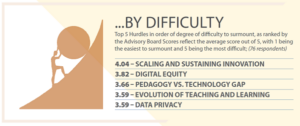What are the main hurdles facing tech innovation in schools? What constraints can be expected to slow down your best-made sales plans for reaching the K12 market? The COSN 2020 edition of the K12 Driving Innovation: Hurdles report, after multiple rounds of Delphi-like voting by more than 102 members of their International Advisory Board of distinguished educational technology experts, has a lot to say about the most worrisome handicaps facing ed-tech decision makers and the companies trying to sell into this market.

In this first in my series of three articles, we will focus on five hurdles that greatly impair the adoption and diffusion of technology in schools. According to the report, these hurdles are more than pesky hindrances. These hurdles are “significant obstacles that make participants slow down, evaluate, practice and then make the leap to better support teaching and learning”.
Although the Driving Innovation: Hurdles 2020 report largely speaks for itself, in this piece I will offer a bit of translation and connection. With full disclosure, I must mention that I served as one of the 102 world-wide panelists who developed this report over many months. Serving as a panelist for the report for the last seven years (Driving K–12 Innovation is the successor to the New Media Consortium’s Horizon K–12 reports, a decade-long series that ended in 2017), I can add beneficial nuance to the findings, from an inside perspective. The full report can be accessed here. A full translation in Chinese can be found here. For now, let’s take a quick look at these five recurring irritants in terms of the difficulty level the advisory board assigned to each of them:
Top 5 2020 hurdles, by level of difficulty. COSN Report.
![]() Scaling and Sustaining Innovation
Scaling and Sustaining Innovation
Translated into the vendor’s vernacular, scaling up sales with past customers and systematizing these sales with repeat and replacement business over time makes it so much easier to do business in the fickle educational market. That’s the ideal. But it’s no surprise that the failure to scale and sustain tech innovation is the chief ogre facing schools today. The problem actually resides on both ends of the equation in this partnership dance: school leaders lack experience in scaling and sustaining innovative projects, always seeming to sacrifice attention density in their eagerness to jump for the next big ‘shiny’ object; and vendors often aren’t patient enough to wrap a bow around repeat business as they starvingly scour the landscape for the next big customer or tender.
![]() Digital Equity
Digital Equity
Digital equity remains a persistent stumbling block in the pathway of moving technology forward in schools. One lesson learned from recent efforts at providing continuity of learning during a worldwide pandemic was that the children who had little access to bandwidth, devices, software/webware, or technical support at home simply ‘disappeared’. Education, for many of these children, came to a full stop. For others, learning was truncated or shrunk. The sinkholes of inequality were apparent everywhere. Digital inequities remain as formidable barriers.
![]() Pedagogy vs the Technology Gap
Pedagogy vs the Technology Gap
The report warns that “governments still focus on providing Internet access, digital content, and equipment to schools, and pay far less attention to helping teachers enhance and transform teaching through technology”. As the report states, “the forced use of technology in a district can blindside educators”.
Unfortunately, this failure to pay attention to the training needs of teachers has been a constant, at least by my count, since the 1980’s. I have long argued that vendors need to supply a training offering (for a fee) along with every sale, and view this as a second revenue stream. Now if principals and district administrators will just take up that offer.
![]() Evolution of Teaching and Learning
Evolution of Teaching and Learning
While technology rolls forward at a dizzying pace, teaching and learning haven’t changed as much as they might seem. Sometimes the disconnect is palpable. Teachers find it easy to get ahead of themselves with all the shiny new technology. The K12 Driving Innovation report still admonishes us that we still focus too much on the technology, and not enough on the learning at hand. The report calls on schools to “actively re-think existing practices, re-imagine learning processes and classroom norms, and re-evaluate learner needs”.
![]() Data Privacy
Data Privacy
If our reader is wondering how and why data privacy can be a barrier to technology adoption in schools, here’s how that works: first, in many districts teachers and schools are strictly prevented by their in-house IT staff from buying or using apps that cannot guarantee student data privacy; second, when there aren’t many apps that can hold up to overly stringent privacy standards, or when it takes so long to get apps that do meet these requirements approved and installed on devices, teachers tend to use those devices less and less. As you can see, this becomes a wicked downward spiral, hindered not by the apps, the devices or the teachers, but by the administrative gatekeepers and the slow crawl of administrative bureaucracies.
 Some Final Thoughts
Some Final Thoughts
An interesting observation that should be made is that the 2020 Hurdles report represents work completed in the late months of 2019, designed for rollout in early to mid 2020. The analysis was done far in advance of the pandemic that has recently shaken our lives and businesses. If this deliberation had been completed after the pandemic struck, there is no doubt that the financial stresses, distancing realities, climate of fear and uncertainty, and resulting general instability would have presented far greater concern as difficult hurdles to surmount for schools. Who could’ve known? – Len Scrogan

